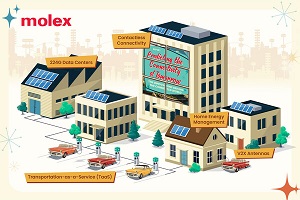Molex releases report, revealing future of technology advancements, product developments

Molex has released a report that highlights opportunities and obstacles facing product design engineers as the future of connectivity continues to unfold. The report, “Predicting the Connectivity of Tomorrow: Innovations Driving the Connected World,” offers insights into changing future connectivity, which is poised to unlock product creations.
“From factory floors and hyperscale data centres to self-driving vehicles and smart, energy-efficient homes, connectivity innovations are shaping our technology future. Every step forward requires cross-disciplinary engineering, world-class manufacturing and constant collaboration with customers to push the boundaries of high-speed, high-power connectors. We’re excited to serve as a catalyst in this global push to lead the evolution of connectivity while accelerating the evolution of life-changing solutions.” says Joe Nelligan, CEO of Molex.
To help product designers and engineers prepare for what lies ahead, Molex’s skillful personnel took a closer look at creations, including:
- Future, contactless connectivity
- Vehicle-to-everything (V2X) communications
- Connected, energy-independent homes
- Centralised, hyperscale hubs of connectivity

Joe Nelligan
Timely observations shed light on the flow of these important creations, as well as their ever-increasing impact on automobiles, consumer devices, factories, medical wearables, smartphones, smart homes, data centres and more. Additionally, Molex offers perspectives on the critical role that connectivity plays in driving the creation of recent business models, such as transportation-as-a-service, which challenges conventional vehicle ownership.
Paving the way for contactless connectivity
Contactless connectors use miniaturised radio frequency (RF) transceivers and receivers to enable devices to communicate and exchange data without requiring physical contact between them. They also support much higher data rates than previously possible with existing wireless protocols, such as Bluetooth and Wi-Fi (wireless fidelity). Distinct security and durability advantages over physical, metal-to-metal contacts make contactless connectors ideal for video displays, harsh environments, sleek and light consumer electronics, as well as industrial robotics. The pace of development in this area is boosting up as companies realise opportunities for streamlined product designs, reduced costs and smooth device pairing.
Navigating road ahead for V2X antennas
Ongoing developments in antennas, sensors and connectors are among the relevant enablers of evolving vehicle-to-everything (V2X) capabilities. Backed by a decade-long roadmap of 5G V2X projects and established in shark-fin antenna development, Molex has set a steady pace of creation in support of self-driving vehicles. Close collaboration with automakers and suppliers is essential to defining optimal antenna placement and performance. Additionally, advancements in non-conductive materials will allow future connected vehicles to incorporate smooth designs without sacrificing connectivity to satellites, Wi-Fi networks and other systems.
Powering connected, energy-efficient homes of the future
Future built homes will combine internet of things (IoT) functionality with battery storage systems to ensure control and visibility over energy production and usage. Creations in energy management, such as mini-inverters for solar panels and smart battery management systems, will improve energy-usage productivity and control. These storage systems are expected to play a crucial role in intelligent monitoring and routing of power wherever required. Molex’s continued focus in this area led to the development of volfinity cell contacting system, which was selected by BMW last spring for its future electric vehicle (EV) class.
Forming connected, hyperscale hubs
Hyperscale data centres built on 224G system architectures will enable artificial intelligence (AI) to help consumers optimise energy consumption while empowering businesses to keep pace with relentless requirements for real-time data processing. The adoption of generative AI is forcing hyperscale data centres to evolve, prompting Molex to pioneer 224 Gbps (Gigabytes per second)-PAM4 (pulse amplitude modulation 4-level) architecture. Molex’s 224G product portfolio offers unparalleled flexibility and scalability, along with superior signal integrity and whole mechanical composition.
Comment on this article below or via Twitter @IoTGN
